
views
Bharat Mata seems to be in distress as two parts of the country — Manipur and Tamil Nadu — claim that she has been hurt and disrespected.
Both incidents have their shock value, raising one question — Is this the Bharat Mata we were taught about in school, the one that embodied “united we stand, divided we fall"?
Let’s understand what happened in both the states.
MANIPUR
Manipur has been seeing clashes between the two ethnic tribal groups – Meitei and Kuki — building up over decades. This issue has been steeped in their history, entangled with identity politics, faith and fierce territorial conflicts.
Congress leader and newly reinstated Wayanad MP Rahul Gandhi launched a blistering attack against the BJP over the violence in Manipur, stating that the Central government’s action has led to the murder of ‘Bharat Mata’.
“Bharat Mata ki hatya aapne Manipur mein ki…," said Gandhi, amid protesting voices of the ruling BJP members and table thumping by the Congress.
Talking about his visit to Manipur, Gandhi asked the Prime Minister why only the Home Minister had gone there. “Do you not consider Manipur a part of India? I used the word Manipur, but the reality is there is no Manipur left. You have divided Manipur into two parts, you have broken up Manipur," Gandhi said.
Prime Minister Narendra Modi was not in the Lok Sabha when Gandhi spoke. He took on the Congress leader on August 11, reminding the Congress that they were responsible for the partition of the country in 1947. “How can the opposition talk about Bharat Mata’s murder when they themselves cut Bharat Mata into three pieces?"
Later, Speaker Om Birla expunged Gandhi’s remarks on ‘Bharat Mata’. Gandhi reacted saying “Apparently, Bharat Mata is an unparliamentary word in India nowadays."
TAMIL NADU
Down south, ‘Bharat Mata’ herself is being drawn into another political clash.
Officials of the Revenue Department in Tamil Nadu’s Virudhunagar removed the statue of Bharat Mata on the premises of the BJP office for installing it “without obtaining necessary permission". It was removed on August 7 at 1 am.
The state unit of the BJP had recently installed a black stone statue of ‘Bharat Mata’. They condemned this, calling it a vitriolic move by the ruling Dravida Munnetra Kazhagam (DMK). They questioned the rationale behind the move as the statue was installed on a private piece of land. Pictures of the revenue officials removing the statue after scaling the walls as the gate were locked began to be circulated.
The officials claimed that there was a government order that said that prior permission is required from the authorities concerned before installing statues. “If the statue was installed inside within four walls of a building, nobody is going to question it. But if kept outside in full public view, adequate permissions need to be taken from the officials," said a senior revenue official.
The BJP countered it by saying that not only was it installed on their premises which was not government land, but the need to seek permission was only for statues of community or political leaders and not of Bharat Mata.
BJP State President K Annamalai not only criticized the action of police officials to remove the statue, but also called it an act of vendetta by the corrupt DMK government.
THE FORMS OF BHARAT MATA
Over centuries, Bharat Mata has emerged in many forms and myriad shades of struggles, ideologies, and political discourse. The very first canvas to showcase Bharat Mata was a painting by noted artist Abanindranath Tagore, the nephew of Nobel Laureate Rabindranath Tagore. He depicted her draped in robes the color of saffron, four arms gracefully bearing a manuscript, a swathe of white cloth, a japamala, and a bundle of grain stalks. This was Tagore’s way of representing the movement against the partition of Bengal.
But this has also been a point of debate when Sugata Bose, the grandnephew of Netaji Subhas Chandra Bose, in his book, said that Bankim Chandra Chattopadhyay, originally invoked the term ‘Bangamata’ as ‘Mother Bengal’, and not Vande Mataram, as it came to be known later.
Another prominent yet controversial depiction of Bharat Mata that was seen as provocative and deplorable was noted artist M. F. Husain’s ‘Bharat Mata’ where she was portrayed in a naked form. It forced Husain to apologize.
In Varanasi, a temple dedicated to Bharat Mata was inaugurated by Mahatma Gandhi. Inside the temple’s sanctum, there is no idol or statue, but a map of India which Gandhi said was a representation that underscores the essence that Mother India, devoid of prejudice, caste, creed, religion, and color.
Bharat Mata was the symbolic face of India’s fight for independence and peaceful coexistence, and continues to be so. Having gone through this tumultuous journey, the essence of Bharat Mata, which is being reiterated today, is aptly reflected in these verses by Sri Aurobindo, India’s noted philosopher and poet:
‘mAtAsmi bhoH putraka bhAratAnAM sanAtanAnAM tridashapriyANAm |
shakto na yAnputra vidhirvipakShaH kAlo aapi no nAshayituM yamo vA ||’
‘I am the mother, O child, of the Bharatas, the eternal people beloved of the gods, whom neither hostile Fate nor Time nor Death has power to destroy.’




















Comments
0 comment